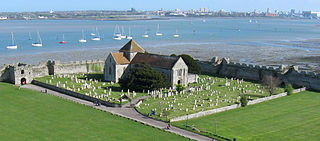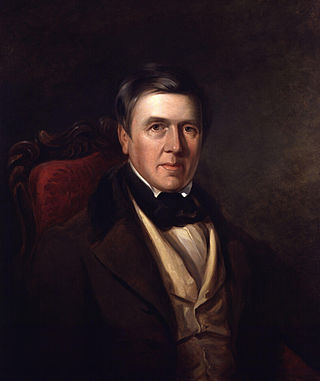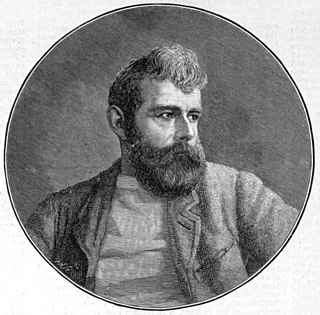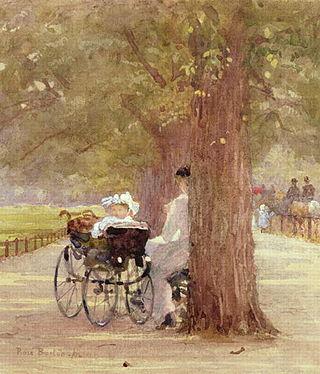Related Research Articles

Portchester is a village in the borough of Fareham in Hampshire, England. It is 4 miles (6.4 km) northwest of Portsmouth and around 18 miles east of Southampton on the A27 road. Its population according to the 2011 United Kingdom census was 17,789.

David Cox was an English landscape painter, one of the most important members of the Birmingham School of landscape artists and an early precursor of Impressionism.

John Frederick Lewis (1804–1876) was an English Orientalist painter. He specialized in Oriental and Mediterranean scenes in detailed watercolour or oils, very often repeating the same composition in a version in each medium. He lived for several years in a traditional mansion in Cairo, and after his return to England in 1851 he specialized in highly detailed works showing both realistic genre scenes of Middle Eastern life and more idealized scenes in upper-class Egyptian interiors with little apparent Western influence.

Sophie Gengembre Anderson was a French-born British Victorian painter who was also active in the United States for extended periods. She specialised in genre paintings of children and women, typically in rural settings. She began her career as a lithographer and painter of portraits, collaborating with Walter Anderson on portraits of American Episcopal bishops. Her work, Elaine, was the first public collection purchase of a woman artist. Her painting No Walk Today was purchased for more than £1 million.

Louise Ingram Rayner was a British watercolour artist.

Eleanor Fortescue-Brickdale was a British artist, a late exponent of Pre-Raphaelitism. She produced paintings in oils and watercolour, book illustrations, and a number of designs for works in stained glass.

William Lionel Wyllie, also known as W. L. Wyllie, was a prolific English painter of maritime themes in both oils and watercolours. He has been described as "the most distinguished marine artist of his day." His work is in the Tate, the Royal Academy, the Imperial War Museum, the National Maritime Museum, the National Museum of the Royal Navy, and many other institutions around the world.

Henry Le Jeune was an English painter of landscapes, genre, literary and biblical scenes. He became well known for his genre paintings of children.

Rose Mary Barton was an Anglo-Irish artist; a watercolourist who painted landscape, street scenes, gardens, child portraiture and illustrations of the townscape of Britain and Ireland. Barton exhibited with a number of different painting societies, most notably the Watercolour Society of Ireland (WCSI), the Royal Academy (RA), the Royal Hibernian Academy (RHA), the Society of Women Artists and the Royal Watercolour Society (RWS). She became a full member of the RWS in 1911. Her paintings are in public collections of Irish painting in both Ireland and Britain, including the National Gallery of Ireland and Dublin City Gallery The Hugh Lane in Dublin, and the Ulster Museum in Belfast.

James Sillett was an English still life and landscape artist. He showed himself to be one of the most versatile of the Norwich School of painters: although the great majority of his works were still lifes and landscapes, he was also a drawing master and a miniaturist. His botanical paintings illustrations have been praised for their accuracy and attention to detail. These and his still life paintings are considered to be his best work, with some experts ranking him with William Jackson Hooker, whose illustrations were both accurate and charming. Sillett's own accurate depictions of plants were often used for book illustrations. His paintings often have an academic style, influenced by the masters of the eighteenth century in a way that set him apart from his Norwich contemporaries. He exhibited at the Royal Academy between 1796 and 1837.
Ann Charlotte Bartholomew (1800–1862), was an English flower and miniature painter, and author.
Maria Spilsbury (1776–1820) was a British artist known for her religious paintings and portraiture.

Henry John Johnson, usually known as Harry was an English landscape and water colour painter.

Marian Emma Chase (1844–1905) was a British painter, water colour artist and draftsperson. She is best known for her flower, fruit and still-life watercolour paintings. The Victoria and Albert Museum holds one of her works.
Helen Cordelia Angell, née Coleman was an English watercolour painter.

Madeline Francis Jane Marrable, née Cockburn was a prolific London based watercolourist and oil painter specialising in landscapes with a preference for mountains and snowscapes. She traveled widely to places including Austria, France, Italy, Ireland, Switzerland and Venice. Noted works include: Ancient Cedars at Ankerwycke, Staines, Moonlight at Chiavenna and The Diligence Halting. She exhibited both in Britain and abroad, including at the Royal Academy between 1864 and 1903. She exhibited her work at the Palace of Fine Arts and The Woman's Building at the 1893 World's Columbian Exposition in Chicago, Illinois. Her painting Isola Bella Lago Maggiore was included in the 1905 book Women Painters of the World. In 1886, Marrable was elected as the first President of the Society of Lady Artists (SLA), formerly the Society of Female Artists (SFA) and since 1899 is now known as the Society of Women Artists (SWA), she retired from the presidency in 1912.
Alethea Garstin (1894–1978) was a Cornish artist and illustrator who exhibited paintings regularly at London's Royal Academy from an early age.
Cecilia Margaret Nairnnée Cecilia Margaret Campbell was an Irish wax modeller and painter. She specialised in landscape watercolour paintings and modelling flowers. Nairn's paintings were exhibited at the Royal Hibernian Academy from 1826 to 1851.
Isabel Naftel, née Oakley, was a British artist known for her portrait, genre and landscape paintings.
Frances Tripp 'Fanny' Rossiter was an English Victorian painter who specialised in drawings and watercolour paintings of birds. She exhibited under her married name of Mrs. C. Rossiter.
References
- Long, Basil Somerset (1912). . In Lee, Sidney (ed.). Dictionary of National Biography (2nd supplement). London: Smith, Elder & Co.
- Yeldham, Charlotte (2004). "Farmer, Emily (1826–1905)". Oxford Dictionary of National Biography (online ed.). Oxford University Press. doi:10.1093/ref:odnb/33080.(Subscription or UK public library membership required.)